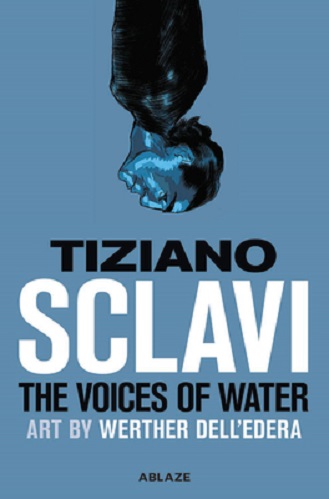Under a persistent rain, which seems destined to never subside, Stavros lives and moves through the streets of a dark and gloomy nameless city…. Several different voices talk to him – sometimes whispering, sometimes whining or yelling – whenever he hears the water running. One day, Stavros wanders the city under a heavy rain; voices become insistent, revealing his deepest, unspeakable secrets as well as his dreams and memories. He is tormented by these mysterious voices, perhaps a sign of his madness. Or perhaps of a wider, collective madness, which infects everyone around him, to the point of being transmitted to the entire universe.
From the first page, this graphic novel — its haunting art style, its near-abstract plot — caught me off guard. The first few illustrations paint the character effectively as a man staving off madness, though we see no proof until the first conversation.
“I hear voices.”
“It’s called schizophrenia.”
“No … I only hear them when the water runs.”
“It’s still called schizophrenia.”
The story, while difficult to follow, doesn’t seem to be the main focus of the book. Instead, it conveys a powerful set of emotions as Stavros follows his Ulysses-esque life with the shadow of the rain’s cries hanging over him. The rain personifies his creeping madness, creating a potent visual connection and freeing the artist to create truly dark outdoor scenes. The art thrives together with the story, using not-quite-straight lines, jagged edges and abstract shapes to further accentuate the plot.
What makes the sparse dialogue stand out is its use of caricature, confronting readers with scenes that aren’t quite as unrealistic as they seem at a first glance. Every one of Stavros’s encounters is dramatized to a point where they beg the question: Could that really happen?
“He’s dead.”
“Keep working. Nothing happened. Call for a cleaner and have the keyboard replaced.”
“…Go back to work, then. I’ll notify HR that there’s an opening.”
Though it’s not explicitly a tragic book, it’s the utter believability that makes this a unique read. It’s a story far removed from good news, one that paints a black-and-white life, points at it and asks: Could this be what you become?
Is this what you’re already becoming?
- Matt Shipley


